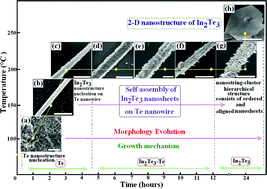Telluride-based nanorods and nanosheets: synthesis, evolution and properties†
Abstract
We report for the first time the synthesis of single crystalline In2Te3

* Corresponding authors
a
National Center for Nanoscience and Technology, Beijing 100190, P. R. China
E-mail:
hej@nanoctr.cn, slf@nanoctr.cn
Fax: +86 1062656765
Tel: +86 1082545670
b School of Material Science and Engineering, Beijing Institute of Technology, Beijing 100081, P. R. China
We report for the first time the synthesis of single crystalline In2Te3

 Please wait while we load your content...
Something went wrong. Try again?
Please wait while we load your content...
Something went wrong. Try again?
M. Safdar, Z. Wang, M. Mirza, F. K. Butt, Y. Wang, L. Sun and J. He, J. Mater. Chem. A, 2013, 1, 1427 DOI: 10.1039/C2TA00470D
To request permission to reproduce material from this article, please go to the Copyright Clearance Center request page.
If you are an author contributing to an RSC publication, you do not need to request permission provided correct acknowledgement is given.
If you are the author of this article, you do not need to request permission to reproduce figures and diagrams provided correct acknowledgement is given. If you want to reproduce the whole article in a third-party publication (excluding your thesis/dissertation for which permission is not required) please go to the Copyright Clearance Center request page.
Read more about how to correctly acknowledge RSC content.
 Fetching data from CrossRef.
Fetching data from CrossRef.
This may take some time to load.
Loading related content
